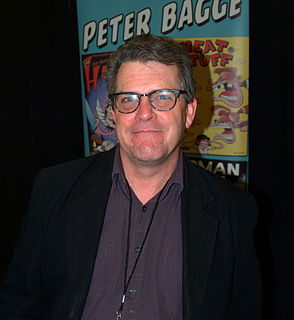
Peter Bagge is an American cartoonist whose best-known work includes the comics Hate and Neat Stuff. His stories often use black humor and exaggerated cartooning to dramatize the reduced expectations of middle-class American youth. He won two Harvey Awards in 1991, one for best cartoonist and one for his work on Hate. In recent decades Bagge has done more fact-based comics, everything from biographies to history to comics journalism. Publishers of Bagge's articles, illustrations, and comics include suck.com, MAD Magazine, toonlet, Discover, and the Weekly World News, with the comic strip Adventures of Batboy. He has expressed his libertarian views in features for Reason.
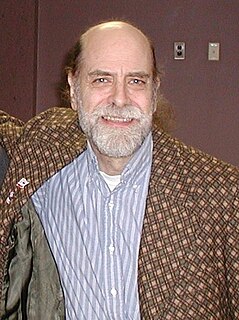
Kim Deitch is an American cartoonist who was an important figure in the underground comix movement of the 1960s, remaining active in the decades that followed with a variety of books and comics, sometimes using the pseudonym Fowlton Means.
Jim is a comic book series by Jim Woodring. It began in 1980 as a self-published zine and was picked up by Fantagraphics Books in 1986 after cartoonist Gil Kane introduced Woodring to Fantagraphics co-owner Gary Groth. The publisher released four magazine-sized black-and-white issues starting in September 1987. A comic book-sized continuation, Jim Volume II, with some color, began in 1993 and ran for six issues until 1996.

Frank is a cartoon character created by American cartoonist Jim Woodring. Frank is a bipedal, bucktoothed animal of uncertain species whom Woodring described as a "generic anthropomorph". The stories and supporting characters appear in a world called the Unifactor.
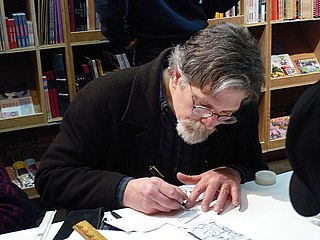
James William Woodring is an American cartoonist, fine artist, writer and toy designer. He is best known for the dream-based comics he published in his magazine Jim, and as the creator of the anthropomorphic cartoon character Frank, who has appeared in a number of short comics and graphic novels.

Daniel Gillespie Clowes is an American cartoonist, graphic novelist, illustrator, and screenwriter. Most of Clowes's work first appeared in Eightball, a solo anthology comic book series. An Eightball issue typically contained several short pieces and a chapter of a longer narrative that was later collected and published as a graphic novel, such as Like a Velvet Glove Cast in Iron (1993), Ghost World (1997), David Boring (2000) and Patience (2016). Clowes's illustrations have appeared in The New Yorker, Newsweek, Vogue, The Village Voice, and elsewhere. With filmmaker Terry Zwigoff, Clowes adapted Ghost World into a 2001 film and another Eightball story into the 2006 film, Art School Confidential. Clowes's comics, graphic novels, and films have received numerous awards, including a Pen Award for Outstanding Work in Graphic Literature, over a dozen Harvey and Eisner Awards, and an Academy Award nomination.

Manuel Rodriguez, better known as Spain or Spain Rodriguez, was an American underground cartoonist who created the character Trashman. His experiences on the road with the motorcycle club, the Road Vultures M.C., provided inspiration for his work, as did his left-wing politics. Strongly influenced by 1950s EC Comics illustrator Wally Wood, Spain pushed Wood's sharp, crisp black shadows and hard-edged black outlines into a more simplified, stylized direction. His work also extended the eroticism of Wood's female characters.

Ivan Brunetti is an Italian and American cartoonist and comics scholar based in Chicago, Illinois.
Al Columbia is an American artist known for his horror-themed alternative comics and illustrations. Comics writer Heidi MacDonald has described him as a "cartoonist’s [cartoonist] whose body of work is as unforgettable as it is slim." His best-known published works include the comic book series The Biologic Show, the art book/graphic novel Pim & Francie: The Golden Bear Days, and short stories such as "I Was Killing When Killing Wasn't Cool" and "The Trumpets They Play!". He also works in other media including painting, printmaking, music, and film.

Carol Tyler is an American painter, educator, comedian, and eleven-time Eisner Award-nominated cartoonist known for her autobiographical comics. She has received multiple honors for her work including the Cartoonist Studio Prize, the Ohio Arts Council Excellence Award, and was declared a Master Cartoonist at the 2016 Cartoon Crossroads Columbus Festival at the Billy Ireland Cartoon Library & Museum.
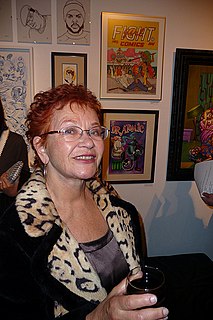
Trina Robbins is an American cartoonist. She was an early and influential participant in the underground comix movement, and one of the first few female artists in that movement. Both as a cartoonist and historian, Robbins has long been involved in creating outlets for and promoting female comics artists. In the 1980s, Robbins became the first woman to draw Wonder Woman comics. She is a member of the Will Eisner Hall of Fame.

Kieron Michael Gillen is a British comic book writer and former computer game and music journalist. He is known for his creator-owned comics Phonogram and The Wicked + The Divine, both created with artist Jamie McKelvie and published by Image Comics, and for numerous projects for Marvel Comics, such as Journey into Mystery, Uncanny X-Men, Young Avengers, and Eternals.
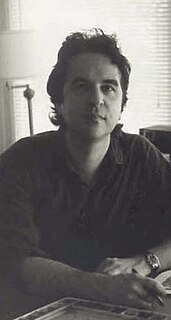
Richard Sala was an American cartoonist, illustrator, and comic book creator with a unique expressionistic style whose books often combined elements of mystery, horror and whimsy.

Rick Altergott is an American alternative cartoonist and illustrator. Altergott is best known for Doofus, a long-running low-brow, scatological series of strips which chronicle the misadventures of two small-town weirdos, Doofus and Henry Hotchkiss.

Jamie McKelvie is a cartoonist and illustrator, known for his both work on books such as Phonogram, Young Avengers and The Wicked + The Divine, and his approach to comic character design.

"I Was Killing When Killing Wasn't Cool" is an 8-page comic by Al Columbia that appeared in the fourth issue of the comics anthology Zero Zero. It was originally created for the never-published third issue (#2) of Columbia's comic book series The Biologic Show. Its title is a play on the song "I Was Country When Country Wasn't Cool".
Saša Rakezić is a Serbian cartoonist, author of such works as Life Under Sanctions, Psychonaut, Dream Watcher, and Bulletins from Serbia.
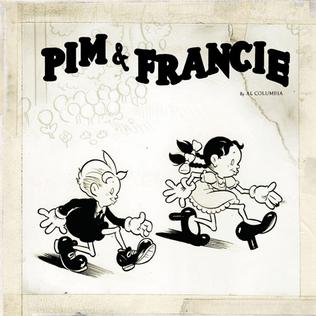
Pim & Francie: The Golden Bear Days is a 2009 book by cartoonist Al Columbia. Subtitled "Artifacts and Bone Fragments", it is a sketchbook-like assemblage of illustrations, paintings, sketches, and unfinished comics featuring his impish, Hansel and Gretel-like characters Pim and Francie, drawn over a period of more than ten years. According to Columbia, the book's fragmentary vignettes "were all attempts [to] make a full-fledged comic and do things right - to put out comics regularly. But it just never really happened that way for me." It was published by Fantagraphics.
Eric Reynolds is a Seattle-based cartoonist, critic and comics editor who works full-time for Fantagraphics Books editing books in addition doing publicity and marketing. His work has appeared in The Stranger, The Comics Journal, The New York Times, The New York Press and other publications. He has edited or co-edited The Complete Crumb Comics, Angry Youth Comics, Dirty Stories and MOME, and has inked some of Peter Bagge's comics.

Amnesia: The Lost Films of Francis D. Longfellow Supplementary Newsletter No. 1 is a 2018 comic book by Al Columbia. Printed in an oversize 11" x 13" format, it is a 24-page collection of posters allegedly created for animated cartoons by the (fictional) titular director/producer and his company, Podsnap Studios. Some of the "lost films" feature Columbia's recurring protagonists Seymour Sunshine and Knishkebibble the Monkey-Boy, who are depicted here as cartoon characters performed by voice actors. The posters also contain references to earlier Columbia stories such as "The Trumpets They Play!" and "I Was Killing When Killing Wasn't Cool", presenting them as Longfellow's creations and tying them into Amnesia's fictional universe.

















